Table of Contents
A good market trip isn’t about rushing through the aisles. It’s about slowing down, noticing what’s in season, and finding ingredients that make food worth eating. Fresh produce markets have a rhythm of their own. Once you understand it, shopping becomes less about habit and more about discovery. You walk in curious, leave with better food, and enjoy the process in between.
Arrive Early and Take Your Time
Markets are at their best in the morning. The air feels cooler, the stalls are full, and sellers are in good spirits. Arriving early means you’ll see everything before the day wears on. You’ll find crisp greens, firm fruit, and herbs that still carry their scent from the field. The best peak hours often fall within those early moments when everything looks its freshest.
Take a slow walk before you buy. Notice which stalls draw attention, who the regulars are talking to, and how the produce looks under natural light. A good market teaches you to pay attention. You’ll start to see the difference between something freshly picked and something that’s been sitting too long. Some produce stands display small signs listing operating days and the farms they source from, which helps you plan future visits.
If you visit Perth Markets, this rhythm feels natural. Sellers chat with familiar faces, weigh bunches of kale, and trim stems without hurry. It’s a place that reminds you food doesn’t need to be fancy to feel special. It simply needs to be handled with care, much like any outdoor market that values its connection to local food and community.
Talk to the People Behind the Stalls
Farmers and vendors are a market’s strongest connection to real food. They know exactly when something was picked, what’s coming next week, and what’s worth skipping today. Ask questions. A simple “What’s tasting good right now?” can tell you more than any sign or label ever could. Many are certified farmers who take pride in offering produce grown with consistency and care.
You’ll often hear stories that make your food more meaningful. Maybe the oranges came from a small grower who uses rainwater irrigation, or the carrots were pulled from sandy soil that gives them a distinct sweetness. Some stalls even carry specialty items such as infused oils, local honey, or small-batch sauces that bring extra character to home cooking.
The more interest you show, the better your experience becomes. Sellers remember good conversations. They might tell you when the first figs arrive or keep a better bunch aside next time. That’s how a simple exchange turns into trust and makes supporting local vendors feel more rewarding.
Learn To Read Freshness
You don’t need special training to recognize good produce. Use your senses. Fresh vegetables look alive with bright color, firm skin, and no soft spots. Fruit should feel full and heavy for its size. A tomato should smell earthy and sweet. Leafy greens should feel crisp, not limp.
Once you start noticing these things, it becomes second nature during the harvest season when produce peaks. Touch and smell are your best guides. A light squeeze or sniff tells you more than packaging ever will. If it looks tired, it probably tastes the same.
Markets give you the chance to choose with confidence, without guessing or relying on labels. Many shoppers also enjoy exploring nearby flea market areas where food and craft meet, creating a mix of texture, color, and character.
Shop With Intention but Stay Open
It helps to arrive with a plan. Maybe you’re cooking dinner, stocking the fridge, or buying fruit for the week. But don’t let a list stop you from exploring. Markets change with the season, and that’s where the best surprises come from.
You might find early mangoes, new potatoes, or a tray of figs that weren’t part of your plan but belong in your basket. Think in meals, not ingredients. If the spinach looks good, imagine how you can use it. If strawberries are everywhere, that’s probably their moment.
The market tells you what’s ready, not the other way around. This approach isn’t only practical; it’s also part of sustainable cooking, where every choice supports fresher food, less waste, and a better way to eat. Some stalls offer gourmet dips and artisanal food that make simple meals feel elevated without extra effort.
Treat What You Buy With Care

Fresh produce doesn’t stay that way for long. Handle it gently when you pack and when you get home. Keep greens cool and slightly damp. Store root vegetables in a dry, shaded space. Separate fruit that ripens quickly, like bananas or apples, so they don’t affect everything else. Take note of market amenities like shaded seating or cold storage areas that help keep food fresh while you shop.
You don’t have to prep everything at once, but rinsing herbs, trimming stems, and organizing what you bought makes a difference. It makes cooking easier during the week and prevents waste. Think of it as an extension of your market trip, especially when you’ve picked up a few greenhouse plants or herbs to grow at home.
When you treat ingredients well, they return the favor. A ripe tomato stays juicy. Crisp lettuce lasts longer. Meals taste fresh because they are. That’s the quiet reward of buying properly, whether you’re exploring produce or small retail activities that add to the market’s character.
Wrapping It Up
Learning how to move through a fresh produce market takes time, but it’s time well spent. Each visit teaches you something new, not through instruction but through experience. And once you understand the rhythm, the market becomes more than a place to shop. It becomes a place to connect, choose well, and enjoy what food is meant to be.
